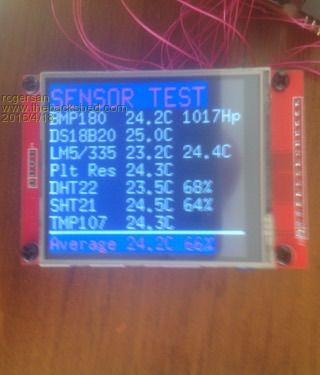
|

|
Forum Index : Microcontroller and PC projects : Sensor comparison
| Author | Message | ||||
| rogersan Regular Member Joined: 10/04/2015 Location: AustraliaPosts: 79 |
Comparing temperature sensors. The BMP180 and TMP107 appear to be the most accurate. The DS18B20 reads about 0.6C high, the DHT22 about 0.8C low, and the SHT21 about 0.3C high. 
|
||||
| Geoffg Guru Joined: 06/06/2011 Location: AustraliaPosts: 3167 |
Interesting. How did you know what the real temperature was? Geoff Graham - http://geoffg.net |
||||
| rogersan Regular Member Joined: 10/04/2015 Location: AustraliaPosts: 79 |
The TMO107 has a typical accuracy of +0.2C Max error +-0.4C. The BMP180 accuracy is typically +-0.5C Max error +-1.5C. As the two are agreeing, it is likely that they are showing nearly the correct temperature. A mercury in glass thermometer (not a finely calibrated one) is reading about 0.8C below the TMP107/BMP180. |
||||
| rogersan Regular Member Joined: 10/04/2015 Location: AustraliaPosts: 79 |
Typical temperature reading errors using BMP180/TMP107 as reference DS18B20. +0.8C DHT.22. -0.9C SHT21. +0.2C |
||||
| piclover Senior Member Joined: 14/06/2015 Location: FrancePosts: 134 |
The most accurate value would be from the DS18B20 (+/-0.2°C typical, at 25°C, and +/-0.5°C over the full temperature range). The BMP180 sensors are very inaccurate for temperatures, not only because the base accuracy is lower (+/-0.5°C typical, +/-1.5°C max, at 25°C) but also because of self-heating (0.65mA during conversion instead of 1mA for the DS18B20, but the latter got a much larger package which dissipates heat much better, and can be located away from the (itself self-heated) circuit board, unlike the SMD BMP180...). The purpose of the BMP180 temperature sensor is not even to provide accurate ambient temperatures but just to allow for temperature compensation of the pressure sensor, according to the calibration coefficients stored in the BMP180 ROM. I don't know about the DHT22 (never used those). Note that for all sensors, it is of uttermost importance to keep them far away from the main circuit board and out of the main circuit board casing: else you will measure the temperature of the circuit board or of the case (and yes, they can both heat up by 1 or 2°C above ambient temperature, even when fitted with low power electronics). To avoid self-heating, you should also avoid doing too frequent measures (1 measure every 15 seconds should make self-heating negligible in most cases). |
||||
| Phil23 Guru Joined: 27/03/2016 Location: AustraliaPosts: 1664 |
Recently did a similar comparison with a hand full of these:- I installed a couple in the supply & return lines from my solar water panels. Needed to know I had matching thermometers to correctly report panel differentials. I compared 6 in a 2 litre jug of water for stability with a -5 to 65°C, 0.5 division spirit thermometer, as well as a clinical one with 0.1 calibration. Found the spread over the sample was in excess of 2.5°C, but did find 3 in the group that displayed the same reading, even though it was 0.4 out. Have also water calibrated a few thermistors in a similar manner over a range of 0 to 65°C. Plan on doing the same with my critical DS18B20's as an error can be significant on low solar days. For non waterproof devices I've put them all in a cardboard box for stability, with the glass thermometer poke thru the side. A good glass thermometer is a handy tool, just be wary about leaving them in the car. Mine usually live in the fridge. Here's some similar. Cheers Phil |
||||